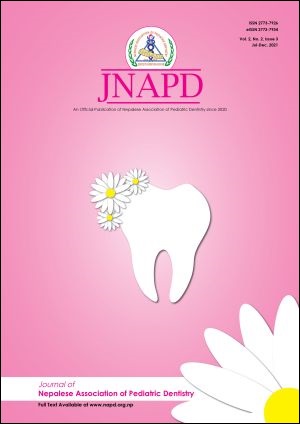Prevalence of Malocclusion and Orthodontic Treatment Needs in Mixed Dentition of School Going Children of Dharan, Nepal
DOI:
https://doi.org/10.3126/jnapd.v2i2.43907Keywords:
Malocclusion, mixed dentition, orthodontic treatment needs, prevalenceAbstract
Introduction: Malocclusion can be defined as a mal-relation between the dental arches in any planes beyond the normal limits. With the rise in concern about good dental appearance, people compare it with success in different fields of life and are always willing to pursue the orthodontic treatment.
Objectives: To determine the prevalence of malocclusion and orthodontic treatment needs according to gender, race and age in mixed dentition of school going children of Dharan, Nepal.
Methods: A cross sectional study was conducted among 830 school children from 10 randomly selected schools from January 2017 to December 2017. The type of malocclusion was determined using a structured questionnaire and the orthodontic treatment need was calculated based on Dental Aesthetic Index (DAI). Chi-square test was used to test the associations.
Results: The prevalence of Class I, Class II division 1, Class II division 2 and Class III malocclusion was 49.11%, 11.43%, 4.03%, and 12.24%, respectively. Normal occlusion was found in 5.79% and 17.39% had asymmetry. The prevalence of orthodontic treatment needs was: 70.06% for slight or no need, 18.67% for elective need, 7.76% for highly desirable need, and 3.52% for mandatory need. Class I malocclusion was statistically significant for both Caucasians and Mongolians and among 8-year-old children (P≤0.001) whereas, 6-and-7-year-old children had no need for orthodontic treatment which was significant (P<0.05).
Conclusion: The study highlights the prevalence of malocclusion to be high with Class I being the most common and nearly one third in need for treatment as assessed by the DAI.
Downloads
Downloads
Published
How to Cite
Issue
Section
License
Copyright (c) 2021 Sapna Agrawal, Bandana Koirala, Mamta Dali, Sneha Shrestha, Tarakant Bhagat, Surya Raj Niraula

This work is licensed under a Creative Commons Attribution 4.0 International License.
This license enables reusers to distribute, remix, adapt, and build upon the material in any medium or format, so long as attribution is given to the creator. The license allows for commercial use.




